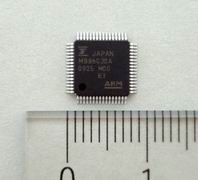 Fujitsu Microelectronics Asia Pte Ltd (FMAL) announced the new USB 3.0 – SATA bridge ICs, built with Fujitsu’s leading-edge proprietary physical layer device (PHY).
Fujitsu Microelectronics Asia Pte Ltd (FMAL) announced the new USB 3.0 – SATA bridge ICs, built with Fujitsu’s leading-edge proprietary physical layer device (PHY).
It supports SuperSpeed USB, the USB 3.0 specification , and enables data transfer rates of 5Gbps maximum between external storage devices – such as hard disk drives (HDDs) – and PCs. The new IC, MB86C30A, is the first in the MB86C30 Series of USB 3.0-SATA bridge ICs, and when embedded in PC peripheral devices, enables over 10-fold faster data transfer rates in comparison to the USB 2.0 specification. In addition to the bridge functionality, the new IC also features a high-speed data encryption/decryption engine, offering high security without impairing the high-speed performance of USB 3.0. Samples of the new MB86C30A IC are available from today, July 27, 2009.

Figure 1: Example of system using the USB-SATA bridge IC

Figure 2: USB 3.0 – SATA bridge IC, MB86C30A (unit: cm)
Today, PCs and digital audio-visual equipment handle an ever-growing volume of data such as digital photos, audio and video files. These market needs are driving storage devices, such as hard disk drives, to have ever-increasing data volumes and speeds. The ubiquitous USB interface, used widely in external hard drives and USB memory sticks, has had a slow maximum data transfer rate of 480Mbps under the USB 2.0 specification, too slow to meet current strong demand for the ability to read and write high volumes of data in shorter time. The USB 3.0 specification (SuperSpeed USB) ratified in November 2008 resolves this issue by providing a maximum data transfer rate that is over 10 times faster than that of USB 2.0. In addition, this revolutionary next-generation specification includes greater protocol efficiency as well as improved power management techniques, which enable lower power consumption.
As this IC series enables 5Gbps high-speed data transfer between the PC and external HDDs, for the case of 3.5-HDDs, copying two hours worth of full high-vision video can be reduced from 12 minutes to approximately 3 minutes 30 seconds to 4 minutes in comparison to USB 2.0
The MB86C30A IC also contains an embedded AES (*4) encryption engine that makes it possible to store encrypted data on HDDs, thus protecting confidential information from threats when portable devices are lost or stolen – a well-publicized problem in recent years – or to prevent data leaks when storage devices are disposed of. In addition, compared to software encryption, this hardware encryption does not burden the CPU of the host PC while providing more secure protection of user’s data.
This series of ICs is being co-developed with Fujitsu Laboratories Limited, utilizing their high-speed serial interface technologies (*5), and Fujitsu LSI Solutions Limited. Going forward, Fujitsu Microelectronics will strengthen and expand its line-up of USB3.0-standard bridge IC products.
Product Features
- One of the first available USB 3.0 (SuperSpeed USB) ICs for PC peripherals to enable high-speed data transferThe new IC is a USB 3.0 – SATA bridge IC for PC peripherals, which features – integrated on a single chip – the USB signal communication control circuits, SATA signal communication control circuits, protocol and command control circuits, and Fujitsu proprietary high-speed serial interface technologies, thus enabling 5Gbps high-speed data transfer.
- High-speed AES encryption/decryption engineThe MB86C30A features an AES encryption/decryption engine – which eliminates the need for encryption software or separate encryption/decryption IC – and makes it possible to encode data stored on external storage HDDs featuring the SATA standard interface, widely used for PCs. Furthermore, the IC supports data transfer speeds that can cover SATA HDD performance, allowing protection of data without impairing high-speed performance or usability.
Source: Fujitsu
